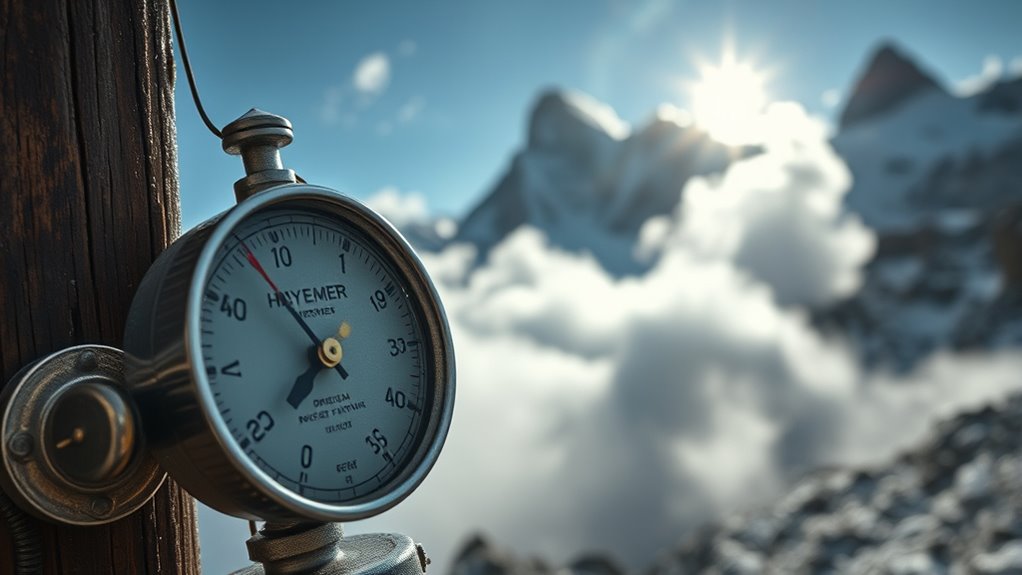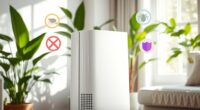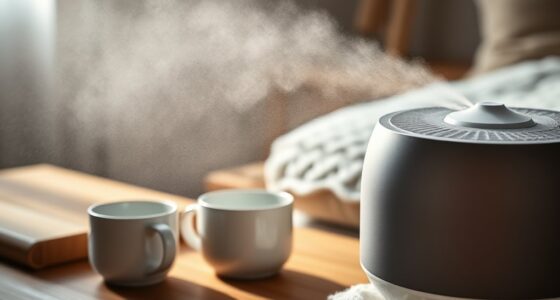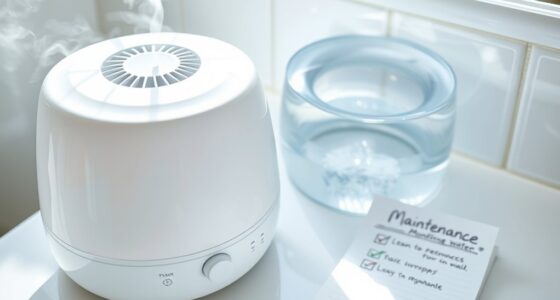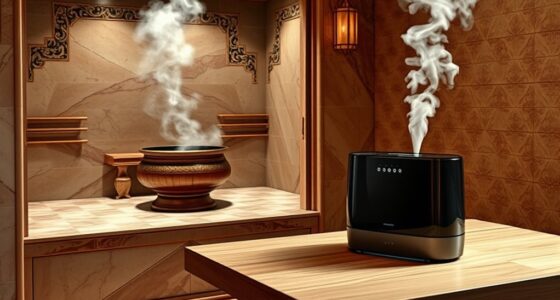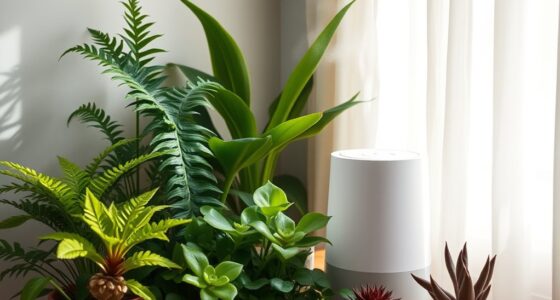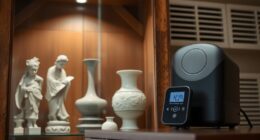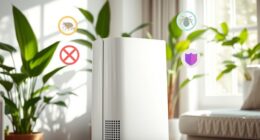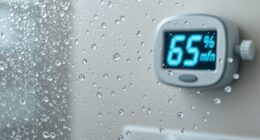Living at high altitude and in humid mountain conditions means you need to adjust your devices carefully. Monitor indoor humidity levels and use humidifiers or dehumidifiers as needed to prevent static or moisture damage. Recalibrate sensors, GPS units, and thermostats regularly to keep readings accurate amid altitude changes. Proper storage and calibration help extend device life and ensure reliable performance. Keep exploring for more tips to optimize your electronics in these unique environments.
Key Takeaways
- Regularly monitor indoor humidity levels and use dehumidifiers or humidifiers to maintain optimal conditions.
- Recalibrate environmental devices like thermostats and weather stations to account for altitude-related measurement shifts.
- Adjust device settings according to manufacturer guidelines to compensate for high altitude and humidity effects.
- Store electronics in sealed containers with desiccants to prevent moisture damage during periods of non-use.
- Ensure GPS and altimeter devices are recalibrated regularly for accurate altitude and navigation data.
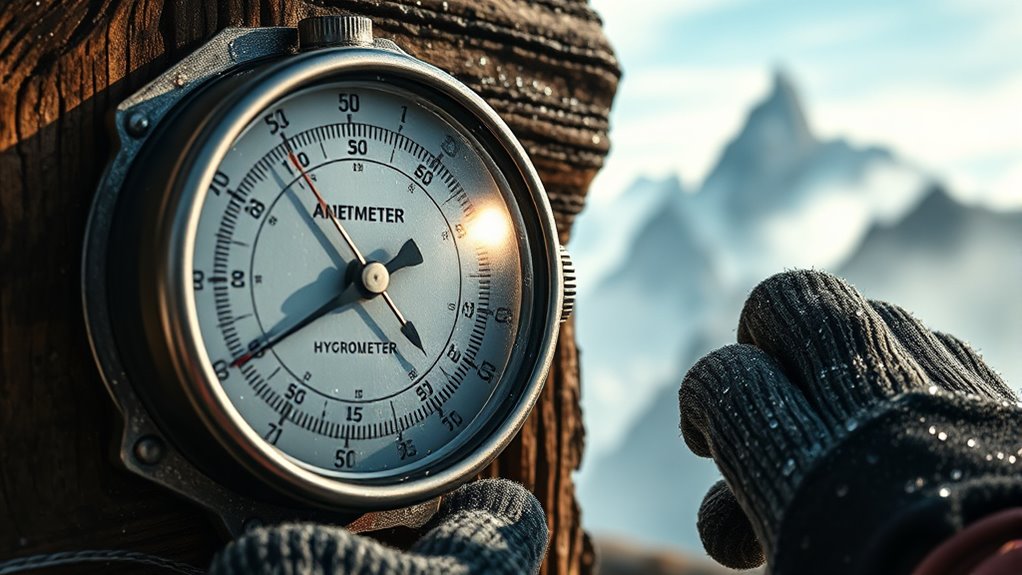
Living in the mountains often means dealing with unique challenges that require adjusting your devices to work efficiently. High altitude and varying humidity levels can markedly impact the performance of your electronics and appliances. To keep everything running smoothly, you’ll need to pay special attention to humidity control and device calibration. These adjustments ensure your devices function correctly despite the environmental changes.
Humidity control is essential because mountain air can be dry or humid depending on the season. Low humidity may cause static buildup, which can damage sensitive electronic components, while high humidity increases the risk of moisture-related issues like corrosion or short circuits. To maintain ideal humidity levels, consider using a dehumidifier or humidifier as needed. These devices help create a stable environment that prevents moisture from interfering with your electronics. Additionally, storing devices in sealed containers or using silica gel packs can help absorb excess moisture, especially when not in use. Proper humidity control not only prolongs the lifespan of your devices but also keeps them operating at peak performance.
Device calibration is another critical step, as altitude and environmental factors can throw off your devices’ accuracy. For example, your thermostat or weather station may need recalibration to account for lower air pressure and different humidity levels. When calibrating, follow the manufacturer’s instructions carefully, often involving adjusting settings or using calibration tools. Regular calibration ensures that your devices provide accurate readings, which is essential for safety and efficiency—whether you’re monitoring temperature, humidity, or other environmental conditions. Keep in mind that some devices might drift out of calibration more quickly in mountain environments, so periodic checks become part of your routine. Additionally, sensor accuracy can be affected by environmental changes, making calibration all the more important.
You should also consider the impact of altitude on electronic devices that rely on sensors or precise measurements. For instance, GPS units and altimeters need recalibration for accuracy at higher elevations. Use calibration features often found in these devices, or refer to manufacturer guidelines to make proper adjustments. Doing so guarantees your navigation remains precise, and your data stays reliable.
Frequently Asked Questions
How Do High Altitudes Affect Electronic Device Batteries?
High altitudes can impact your electronic device batteries by increasing battery degradation and altering power consumption. You might notice your devices drain faster because cold temperatures slow chemical reactions inside the battery. Additionally, the reduced oxygen levels can affect overall performance. To keep your devices working smoothly, avoid extreme cold, and consider turning off unnecessary features. Proper care helps minimize battery degradation and maintains peak power use in high-altitude environments.
Are There Specific Humidifiers Designed for Mountain Environments?
Did you know that mountain humidifiers can boost alpine moisture levels by up to 20%? You should look for mountain humidifiers specifically designed for high-altitude environments. These devices are built to handle the drier air and lower oxygen levels, ensuring your space stays comfortably moist. Using a specialized mountain humidifier helps prevent dry skin, respiratory issues, and keeps your devices functioning effectively in alpine conditions.
How Often Should I Calibrate My Devices in High Humidity?
You should calibrate your devices regularly to guarantee accuracy, especially when dealing with high humidity, which can impact their performance. Typically, recalibrate every few months, but if you notice discrepancies or environmental conditions change substantially, increase calibration frequency. Humidity impact can cause sensors to drift, so staying vigilant and calibrating as needed helps maintain device reliability and precision. Regular checks keep your devices functioning at their best in challenging conditions.
Can Altitude Cause Damage to Sensitive Electronic Components?
Altitude can cause damage to sensitive electronic components due to pressure effects that might stress seals and enclosures. Additionally, lower oxygen levels and increased radiation can accelerate electronic corrosion over time. You should regularly inspect and maintain your devices, especially if exposed to high altitudes, to prevent electronic corrosion and manage pressure effects. Properly sealed and rated equipment helps mitigate these risks, ensuring your electronics stay functional and safe.
What Are the Best Practices for Protecting Devices From Sudden Weather Changes?
When facing sudden weather changes, you need to stay one step ahead. Use waterproof casings and weatherproof covers to shield your devices from rain, snow, or dust. These protections act like a fortress, keeping moisture and debris out. Always check weather forecasts before heading out, and carry portable covers for quick protection. By taking these precautions, you guarantee your devices stay safe and functional, no matter what Mother Nature throws your way.
Conclusion
Living at high altitude and humidity requires you to tweak your devices regularly. By making these adjustments, you guarantee your gadgets perform at their best and last longer. Don’t you want to enjoy the breathtaking mountain views without tech troubles? Stay mindful of your device settings, and you’ll keep everything running smoothly amidst the mountain’s challenges. After all, adapting your devices is the key to seamless mountain living—so why not start today?
